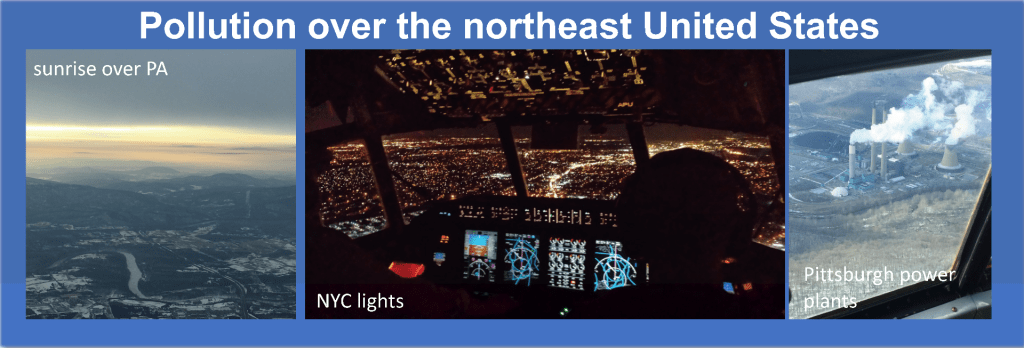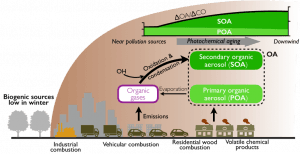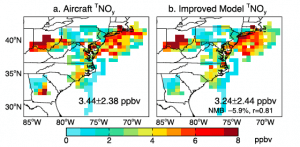
We participated in the NSF Wintertime INvestigation of Transport, Emissions, and Reactivity (WINTER) aircraft campaign. WINTER took place in February-March 2015, with the NCAR/NSF C-130 aircraft conducting 13 flights sampling the lower troposphere  during both day and night. The goal of this experiment was to provide observations allowing us to examine poorly understood wintertime processes near polluted regions in the NE US.
during both day and night. The goal of this experiment was to provide observations allowing us to examine poorly understood wintertime processes near polluted regions in the NE US.
During the Summer of 2024 we will take part in the Greater New York Oxidant Trace gas Halogen and Aerosol Airborne Mission (GOTHAAM) aircraft campaign. This is a collaborative field experiment to study the atmospheric chemistry of the New York City air plume and to understand the sources and sinks of air pollution in the region.
Some of our findings:
Shah, V., et al. (2018). Chemical feedbacks weaken the wintertime response of particulate sulfate and nitrate to emissions reductions over the eastern United States. Proceedings of the National Academy of Sciences. PDF. In the eastern United States, substantial cuts in sulfur dioxide and nitrogen oxides emissions have considerably lowered particulate sulfate and nitrate concentrations for all seasons except winter.  Simulations that reproduce detailed airborne observations of wintertime atmospheric chemistry over the eastern United States indicate that particulate sulfate and nitrate formation is limited by the availability of oxidants and by the acidity of fine particles, respectively. These limitations relax at lower ambient concentrations, forming particulate matter more efficiently, and weaken the effect of emission reductions. These results imply that larger emission reductions, especially during winter, are necessary for substantial improvements in wintertime air quality in the eastern United States. Our results were highlighted in a press release.
Simulations that reproduce detailed airborne observations of wintertime atmospheric chemistry over the eastern United States indicate that particulate sulfate and nitrate formation is limited by the availability of oxidants and by the acidity of fine particles, respectively. These limitations relax at lower ambient concentrations, forming particulate matter more efficiently, and weaken the effect of emission reductions. These results imply that larger emission reductions, especially during winter, are necessary for substantial improvements in wintertime air quality in the eastern United States. Our results were highlighted in a press release.
Shah et al. (2019). Widespread pollution from secondary sources of organic aerosols during winter in the northeastern United States. Geophysical Research Letters. Link. Secondary organic aerosol (SOA) from pollution sources is thought to be a minor component of organic aerosol (OA) and fine particulate matter beyond the urban scale. Here we present airborne observations of OA in the northeastern United States, showing that 58% of OA over the region during winter is secondary and originates from pollution sources. We observed a doubling of OA mass from  SOA formation in aged emissions, with unexpected similarity to OA growth observed in polluted areas in the summer. A regional model with a simple SOA parameterization based on summer measurements reproduces these winter observations and shows that pollution SOA is widespread, accounting for 14% of submicron particulate matter in near‐surface air. This source of particulate matter is largely unaccounted for in air quality management in the northeastern United States and other polluted areas.
SOA formation in aged emissions, with unexpected similarity to OA growth observed in polluted areas in the summer. A regional model with a simple SOA parameterization based on summer measurements reproduces these winter observations and shows that pollution SOA is widespread, accounting for 14% of submicron particulate matter in near‐surface air. This source of particulate matter is largely unaccounted for in air quality management in the northeastern United States and other polluted areas.
EOS Highlight: A New Look at Winter Air Quality in the Northeastern U.S.
Jaeglé et al. (2018). Nitrogen oxides emissions, chemistry, deposition, and export over the Northeast United States during the WINTER campaign. Journal of Geophysical Research. Link. Nitrogen oxides are a key family of pollutants emitted by cars, electric utilities, and industry. The fate of  nitrogen oxides remains poorly understood especially during the winter season, when low sunlight leads to their persistence in the atmosphere. We analyze comprehensive aircraft observations of nitrogen oxides and their atmospheric products over the Northeast United States during winter 2015. This detailed chemical information allows to resolve a long-standing overestimate of the oxidation products of nitrogen oxides and places new constraints on their deposition to land ecosystems and export to the global atmosphere.
nitrogen oxides remains poorly understood especially during the winter season, when low sunlight leads to their persistence in the atmosphere. We analyze comprehensive aircraft observations of nitrogen oxides and their atmospheric products over the Northeast United States during winter 2015. This detailed chemical information allows to resolve a long-standing overestimate of the oxidation products of nitrogen oxides and places new constraints on their deposition to land ecosystems and export to the global atmosphere.
People: Viral Shah, Kelsey Larson, Jessica Haskins, Joel Thornton, Lyatt Jaeglé and WINTER science team
Funding: National Science Foundation (NSF)
Publications
- Haskins, J. D., Lopez-Hilfiker, F. D., Thornton, J. A., Jaeglé, L., Shah, V., Lee, B. H., Campuzano-Jost, P., Schroder, J. C., Day, D. A., Guo, H., Sullivan, A. P., Weber, R., Dibb, J., Campos, T., Jimenez, J. L., and Brown, S. S., 2019. Anthropogenic Control On Wintertime Oxidation of atmospheric pollutants. Geophys. Res. Lett., 46, 14826– 14835. https://doi.org/10.1029/2019GL085498
- Shah, V., Jaeglé, L., Jimenez, J. L., Schroder, J. C., Campuzano-Jost, P., Campos, T. L., Reeves, J. M., Stell, M.,Brown, S. S., Lee, B. H., Lopez-Hilfiker, F. D., Thornton, J. A., 2019. Widespread pollution from secondary sources of organic aerosols during winter in the northeastern United States. Geophys. Res. Lett., 46, 2974– 2983. https://doi.org/10.1029/2018GL081530
- Shah, V., Jaeglé, L., et al., 2018. Chemical feedbacks weaken the wintertime response of particulate sulfate and nitrate to emissions reductions over the eastern United States. Proc. Nat. Acad. Sci. 201803295. https://doi.org/10.1073/pnas.1803295115 [Press Release] Highlighted by [U.S. News] [Physics World] [News Medical] [Newswise][ScienceDaily]
- Jaeglé, L., Shah, V., Thornton, J., Lopez-Hilfiker, F., Lee, B., et al., 2018. Nitrogen oxides emissions, chemistry, deposition, and export over the Northeast United States during the WINTER aircraft campaign. J. Geophys. Res. – Atmos. 123. https://doi.org/10.1029/2018JD029133
- Haskins, J. D., Jaeglé, L., Shah, V., Lee, B. H., Lopez‐Hilfiker, F. D., Campuzano‐Jost, P., et al. (2018). Wintertime gas‐particle partitioning and speciation of inorganic chlorine in the lower troposphere over the Northeast United States and Coastal Ocean. J. Geophys. Res. – Atmos., 123,12,897–12,916. https://doi.org/10.1029/2018JD028786
- Kenagy, H.S., et al., 2018. NOx Lifetime and NOy Partitioning During WINTER. J. Geophys. Res.-Atmos. 123, 9813–9827. https://doi.org/10.1029/2018JD028736
- Lee, B. H., et al. (2018). Airborne observations of reactive inorganic chlorine and bromine species in the exhaust of coal‐fired power plants. Journal of Geophysical Research: Atmospheres, 123, 11,225–11,237. https://doi.org/10.1029/2018JD029284 Highlighted in [GeoSpace]
- Lee, B.H., et al., 2018. Flight Deployment of a High-Resolution Time-of-Flight Chemical Ionization Mass Spectrometer: Observations of Reactive Halogen and Nitrogen Oxide Species. J. Geophys. Res.-Atmos. 123, 7670–7686. https://doi.org/10.1029/2017JD028082
- McDuffie, E.E., et al., 2018. Heterogeneous N2O5 Uptake During Winter: Aircraft Measurements During the 2015 WINTER Campaign and Critical Evaluation of Current Parameterizations. J. Geophys. Res.-Atmos.123, 4345–4372. https://doi.org/10.1002/2018JD028336
- Schroder, J.C., et al., 2018. Sources and Secondary Production of Organic Aerosols in the Northeastern United States during WINTER. J. Geophys. Res.-Atmos. 123, 7771–7796. https://doi.org/10.1029/2018JD028475
- Sullivan, A. P., Guo, H., Schroder, J. C., Campuzano‐Jost, P., Jimenez, J. L., Campos, T., Shah, V., Jaeglé, L., Lee, B. H., Lopez-Hilfiker, F. D., Thornton, J. A., Brown, S. S., Weber, R. J. (2019). Biomass burning markers and residential burning in the WINTER aircraft campaign. Journal of Geophysical Research: Atmospheres, 124. https://doi.org/10.1029/2017JD028153
- Zhu, L., et al., 2017. Formaldehyde (HCHO) As a Hazardous Air Pollutant: Mapping Surface Air Concentrations from Satellite and Inferring Cancer Risks in the United States. Environ. Sci. Technol. 51, 5650–5657. https://doi.org/10.1021/acs.est.7b01356